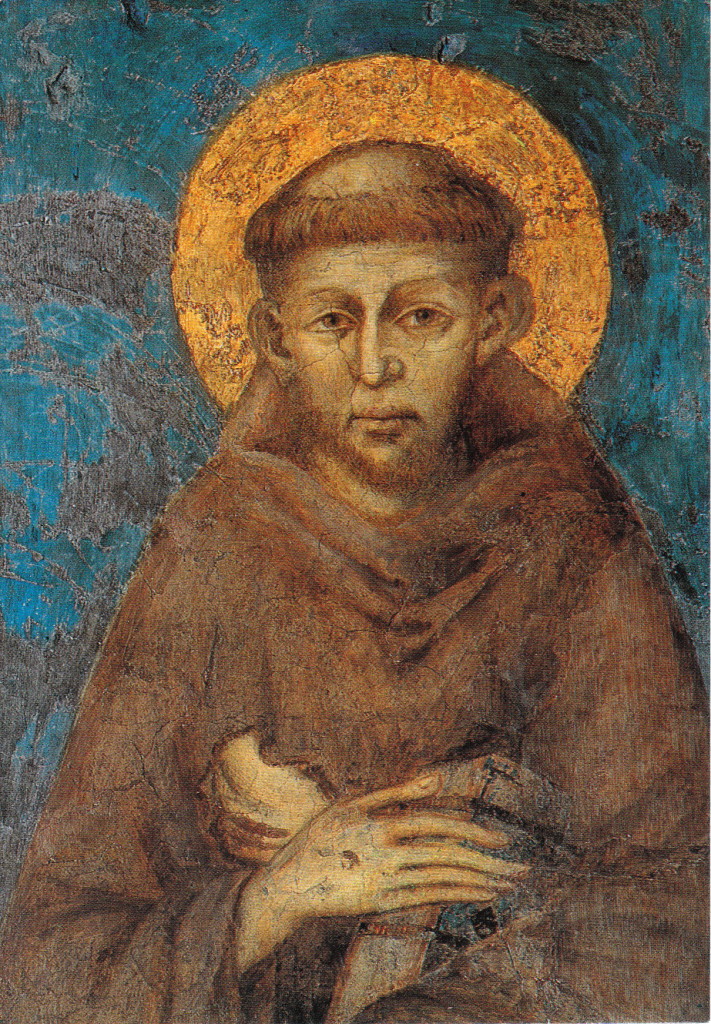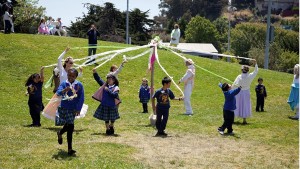Posts Tagged ‘Saint Francis of Assisi’
We Are The Universe!
“Reality is merely an illusion, albeit a very persistent one.”
“Our separation of each other is an optical illusion of consciousness.”
~ Albert Einstein
“Objective reality does not exist” ….
“the universe is fundamentally a gigantic … hologram”
~ David Bohm, Quantum Physicist
“Every particle of the world is a mirror.
In each atom lies the blazing light of a thousand suns.”
~ Mahmud Shabestari, Sufi Mystic, 15th century.
“There is an endless net of threads throughout the universe.
The horizontal threads are in space. The vertical threads are in time.
At every crossing of the threads, there is an individual.
And every individual is a crystal bead. And every crystal bead reflects not only the light from every other crystal in the net,
but also every other reflection throughout the entire universe.”
~ Indra’s Net – from the Vedas of ancient India, 7000 years old
“Reality” isn’t REAL!
“Reality” is a holographic theater of the mind,
where we are microcosmic mirrors of the macrocosm.
~ Ron Rattner, Sutra Sayings
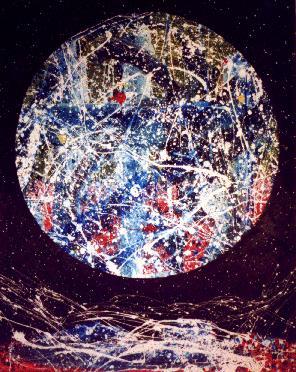
Introduction
Dear Friends,
The following written and recited poetic verses, together with explanatory comments and above quotations, supplement the related “What Is The Universe?” posting.
Both postings propose that cosmically “We Are The Universe”. They are intended to help us open our hearts to all beings and all life everywhere.
Please consider them accordingly.
Ron Rattner
We Are The Universe!
The “universe” is like a cosmic hologram:
An ever changing but persistent illusion
appearing in an eternal, immutable,
infinite ocean of Awareness –
Awareness arising from pure potentiality.
Each of us is an integral, pin-point part of the whole picture,
which wouldn’t be complete without us.
But, though we appear as only a speck of the Whole,
we are like parts of a hologram;
Hidden within each of us is the whole cosmic picture,
and the awareness screen
on which we envision and project the picture.
In our Essence, we and the “universe” are ONE.
So, we are the “universe”.
Ron’s audio recitation of “We Are The Universe”
Ron’s reflections on Non-dualism and “We Are The Universe”
Dear Friends,
Today’s We Are The Universe! posting together with the related “What Is The Universe?” posting propose that cosmically “We Are The Universe”.
These and many more SillySutras writings pertain to non-dualism – an important philosophy which has inspired many recent Silly Sutras writings about spiritual evolution and the nature of “reality”.
From childhood we have been taught to self-identify only with an illusory and disempowering ego image; with a separate body, name, gender, and story about who and what we are. We are taught that we are each born into Nature as limited mortal beings; but not that Nature is our nature, or that we are Beings of Light sharing limitless immortal cosmic consciousness with all life-forms.
Thus, for countless ages human ignorance of our true identity and immortality, has resulted in our hallucination of separation from Nature, from each other, and from our sole Self and spirit, with consequent destructive selfishness and suffering.
Yet, for millennia sages, seers and mystics have been trying to tell us that we inevitably suffer from radically mistaken self-identity; that our self-identity and reality are not what they appear to be; that it is possible to limit or avoid most suffering of ordinary human existence through experiential self-identification with the unseen Eternal spiritual Source of all space-time causality ‘reality’.
Soon after my mid-life change of life, I began discovering enduring wisdom teachings about the Vedic path of Advaita, the oldest extant school of Indian Philosophy. Advaita means non-dualism, and its teachings are about experiencing non-dual Self Realization via focused self-inquiry – relentlessly asking “Who am I?”.
I first found these teachings in books by or about legendary Indian sages J. Krishnamurti, Swami Vivekananda, and Shri Ramana Maharshi; also in New Dimensions Radio interviews by Michael Toms, and in KPFA radio lectures by Alan Watts, contemporary Western philosopher/teacher of Eastern spiritual wisdom, from which I learned about similar Buddhist and Taoist non-dualist philosophies.
After initial perplexity, I gradually became convinced of the ultimate Truth of non-dualistic teachings, as eloquently explained by Swami Vivekananda that:
“…this separation between man and man, between nation and nation, between earth and moon, between moon and sun . . does not exist, it is not real” ; and that
“Your own will is all that answers prayer, only it appears under the guise of different religious conceptions to each mind. We may call it Buddha, Jesus, Krishna, but it is only the Self, the ‘I’.”
~ Swami Vivekananda – “Jnana Yoga”
Non-dualism has even seemed quite consistent with the primary prayer of my early Jewish acculturation:
“Hear O Israel the Lord our God, the Lord is ONE”
~ Deuteronomy 6:4; Mark 12:29
Yet, while accepting Eastern non-dualism wisdom teachings, I have continuously displayed preponderantly devotional propensities of praying, calling and crying to the Divine. And in reading hagiographies I have most identified with Saint Francis of Assisi and Shri Ramakrishna Paramahansa – both extremely ascetic and devotional holy men – more than with the wisdom teachers who introduced me to non-dualism.
Until retirement, while maintaining my busy law practice I found limited time to read and reflect on non-dualism teachings, except on weekends. So I used to jestingly tell spiritual friends that on weekdays I prayed and cried as a devotional bhakta, but that on weekends I became a “Seventh Day Advaitist”.
Ultimately, I’ve become an every day – not just a seventh day – Advaitist. So whimsically I sometimes say that I am now a devotionally open-minded “Advaitist-fundamentalist”.
While accepting non-dualism, my primary path seems devotional. Over forty years since beginning to cry for God, I still frequently display devotional tendencies of spontaneously praying, singing, and calling to the Divine. Apparently, my Guruji was quite prescient in naming me Rasik – “one engrossed in devotion”.
As a devotional “Advaitist-Fundamentalist” I have composed many poems and essays encouraging the heartfelt path of ‘non-dualism’ – including today’s “We Are The Universe” quotations and poem.
May these writings help remind, encourage and inspire us to open our hearts with deep empathy and compassion for all people and all Life everywhere.
And so may it be!
Ron Rattner
We Create “Reality”
Embedded below is a helpful 10 minute YouTube video montage titled “We Create “Reality””, previously linked on the related What Is the Universe posting
Should We Be Seekers?
~ Question, Quotations, and Comments
“He is born in vain,
who having attained the human birth,
so difficult to get,
does not attempt to realize God
in this very life.”
~ Sri Ramakrishna
“Seek first the kingdom of heaven,
which is within.”
~ Matthew 6:33; Luke 17:20-21
“Seek and ye shall find.”
Matthew 7:7; Luke 11.9-13
“What you seek is seeking you.”
~ Rumi
“What we are looking for is what is looking.”
~ St. Francis of Assisi
By letting it go it all gets done.
The world is won by those who let it go.
But when you try and try,
the world is beyond the winning.
~ Lao Tzu
“Remember God; forget the rest.
Forget who you think you are,
to remember what you really are.”
~ Ron Rattner, Sutra Sayings
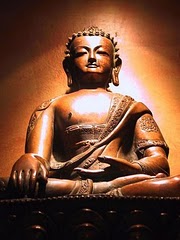
Introduction
This posting asserts and explains, with quotations and comments, that consciously or unconsciously we are all spiritual seekers.
Should We Be Seekers?
Q. Should we be seekers?
A. Knowingly or unknowingly everyone’s a seeker.
Knowingly or unknowingly everyone seeks Self.
But seeking’s then,
while Self is NOW.
So, to find Self,
BE Self –
NOW!
Ron’s audio recitation of “Should We Be Seekers?”
Ron’s comments and explanation of “Should We Be Seekers?”
Dear Friends,
Are you a spiritual seeker – a seeker of Eternal Truth?
Nowadays, few humans consciously seek spiritual Truth. Almost everyone wants to be happy. But most people seek happiness in worldly pursuits and pleasures, not within.
For millennia mystics, saints and sages have counseled us to focus on spiritual rather than worldly goals. They tell us that worldly pleasures and attainments can merely bring transient satisfactions, whereas lasting happiness can only be found within.
Thus Jesus advised:
“Seek first the kingdom of heaven, which is within.”
“Seek and ye shall find.”
~ Matthew 6:33; Luke 17:20-21; Matthew 7:7; Luke 11.9-13
Similarly, 19th century Indian holy man Sri Ramakrishna Paramahansa said:
“He is born in vain, who having attained the human birth, so difficult to get, does not attempt to realize God in this very life.”
~ Sri Ramakrishna
From my experience, knowingly or unknowingly, everyone is a spiritual “seeker” because everyone longs for a state of being which transcends inevitable Earthly cares and suffering, bringing eternal happiness as LOVE. But rare are those who attain it.
Background
In memoirs titled “Transcending Transcendence” I’ve told how soon after becoming a “born-again Hindu”, I learned that that the object of Sanskrit Hindu practices given by my Guruji was to achieve “mukti” or “moksha”, a state of Divine illumination, where the Self, soul, or “Atman” would experience its Oneness with “Brahman” [Supreme Reality] – the pinnacle of human experience.
Thereafter, I began considering and seeking “self realization”, or “enlightenment” as a spiritual goal, until gradually I abandoned goal oriented spiritual seeking, and – as “An Uncertain Undo” – intuitively began surrendering to the Infinite, with ever expanding heartfelt faith in God.
Explanation
Mystics say that by resolutely looking within we can discover ultimately that we are imprisoned by illusionary mental tendencies and mistaken beliefs about self identity and reality which wrongly reify our limited perceptions of ephemeral forms, in an ever impermanent illusory reality, where mortality and suffering are karmically inevitable.
So, how can we find divine happiness within?
Non-dualist masters tell us that effortlessly – with resolute intention, intense aspiration and focused observation we can discover our eternal Self, as a joyous state of spiritual freedom beyond belief.
“What is the worth of a happiness for which you must strive and work? Real happiness is spontaneous and effortless.”
~ Sri Nisargadatta Maharaj
“Happiness is the absence of the striving for happiness.”
~ Chuang-Tzu
By letting it go it all gets done. The world is won by those who let it go. But when you try and try, the world is beyond the winning.
~ Lao Tzu
“In the pursuit of learning every day something is gained.
In the pursuit of Tao, every day something is dropped.”
~ Lao Tzu
“Don’t seek happiness. If you seek it, you won’t find it, because seeking is the antithesis of happiness. Happiness is ever elusive, but freedom from unhappiness is attainable now, by facing ‘what is’ rather than making up stories about it. Unhappiness covers up your natural state of well-being and inner peace, the source of true happiness.”
~ Eckhart Tolle, A New Earth
“Do not search for the truth;
only cease to cherish opinions.
Do not remain in the dualistic state.
Avoid such pursuits carefully.
If there is even a trace of this and that,
of right and wrong,
the mind-essence will be lost in confusion.”
~ Seng-Ts’an, The Third Patriarch of Zen
Dedication and Invocation
May the non-dualist mystic masters inspire us –
each from our unique perspective –
to prioritize spiritual rather than worldly goals,
and so to seek and find relief from belief –
relief from mistaken mental tendencies
from which we inevitably and repeatedly suffer
until we find –
beyond the mind –
our true immortal Self.
And thus discover that:
We are what we seek!
And so it shall be!
Ron Rattner
Is Birth On Earth a Death Sentence?
~ Ron’s Memoirs
“Death is truly part of life …
‘what we called death is merely a concept’.”
“This happens at the gross level of the mind.
But neither death nor birth exist at the subtle level of consciousness that we call ‘clear light.’”
~ Dalai Lama
At my death do not lament our separation…
As the sun and moon but seem to set,
in Reality this is a rebirth.
~ Rumi
In order to know through experience what happens beyond death, you must go deep within yourself.
In meditation, the truth will come to you.”
~ Shri Dhyanyogi Madhusudandas
“And it is in dying [to ego life]
that we are reborn to eternal life.”
~ Peace Prayer of St. Francis of Assisi, edited by Ron Rattner
Q: What is death?
A: “Death is a vacation –
Eternal Life-force vacating a transient vehicle –
“a space-time soul suit”
~ Ron Rattner, Sutra Sayings
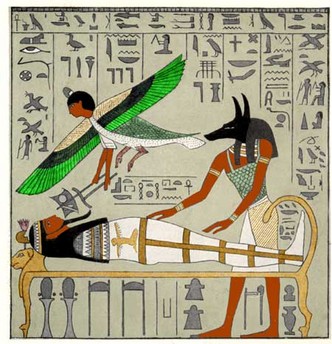
Ron’s Introduction
Knowingly or unknowingly most people fear physical death because they self-identify only with their physical bodies, mistakenly believing that bodily death ends life, and they are ignorant of what if anything happens after physical death.
Such fear of death often motivates selfish thoughts, emotions and behaviors, which dim our inner divine light and render us susceptible to subliminal shadow side neurotic, demonic or dark forces – subhuman malignant energies or entities which parasitically polarize, divide and exploit humankind, by provoking selfishness, violence, anger, anxiety, and fear.
Thus, our fear of death can significantly impede spiritual evolution, whereas losing and transcending fear of death can allow and encourage important evolutionary advancement.
Until my midlife spiritual awakening, like most humans I self-identified with only my physical body, its thoughts and story. But then, in my early forties, I had previously unimagined and irreversibly transformative experiences of spiritual self-identity and afterlife, from which I realized that I was not merely my body, its thoughts and story, but eternal and universal awareness. Since then I have been blessed with a wonderful new life period of ever increasing happiness and fulfillment.
The above quotations and sutras, and the following poetic verses about whether birth on Earth is a death sentence, epigrammatically summarize what I have experientially learned about physical death. They are explained in greater detail in comments following the poem.
Is Birth On Earth a Death Sentence?
No matter how we strive,
No body leaves alive.
But we never really die – you see,
Just leave our physicality
To melt and merge with Mystery,
The mystery of Divinity.
Ron’s audio recitation of “Is Birth On Earth a Death Sentence?”
Ron’s comments on “Is Birth On Earth a Death Sentence?”
Dear Friends,
Physical death is inevitable and natural. All physical bodies are mortal and die; only time of physical death is unknown.
Knowingly or unknowingly most people fear physical death because they self-identify only with their physical bodies, mistakenly believing that bodily death ends life, and are ignorant of what if anything happens after physical death.
Eminent Greek philosopher Socrates was sentenced to death after being unjustly tried and convicted for allegedly corrupting the youth of Athens. Just before he died of a coerced suicide, by drinking hemlock, Socrates proclaimed that fear of death was fear of the unknown:
“To fear death, my friends, is only to think ourselves wise, without being wise: for it is to think that we know what we do not know. For anything that men can tell, death may be the greatest good that can happen to them: but they fear it as if they knew quite well that it was the greatest of evils. And what is this but that shameful ignorance of thinking that we know what we do not know?”
Like most other Americans, I was acculturated with an innate but largely subconscious fear of death. Then in my early forties, I had irreversibly transformative experiences of spiritual self-identity and afterlife:
I realized that I was not merely my body, its thoughts and story, but eternal and universal awareness. And I began seeing visions of apparent past lives, and inner and outer appearances of deceased people, including Mahatma Gandhi, my first perceived inner spiritual guide.
Thus, I began accepting Eastern ideas of reincarnation and transmigration of an eternal soul, while gradually losing fear of inevitable physical death. Ultimately I concluded from experience and intuition that cosmically there is no death; that “birth and death are virtual, while Life is perpetual”. (See e.g.Know Death to Know Life; Know Death to Know That There is No Death)
So I’ve shared the foregoing whimsical poem, quotes and comments about birth and death to help remind us that as we lose fear of death we gain ever increasing peace of mind and happiness. And to explain why transcending fear of death is especially important during current polarized and turbulent times.
Invocation
May we realize that physical death is normal and necessary,
and not to be feared;
that it opens us to ever expanding
new vistas of self-discovery and fulfillment
of our deepest aspirations as eternal souls;
that beyond physical birth and death
we are destined to discover and enjoy
ever increasing inner peace and happiness
until we melt and merge with Mystery,
The mystery of Divinity.
And so may it be!
Ron Rattner
Remembering An Attitude Of Gratitude – A Holy Encounter ~ Ron’s Memoirs
“The deeds you do may be the only sermon some persons will hear today”
~ St. Francis Of Assisi
“I’ve learned that people will forget what you said,
people will forget what you did,
but people will never forget how you made them feel.”
~ Maya Angelou
“If you could only sense how important you are to the lives of those you meet; how important you can be to the people you may never even dream of.
There is something of yourself that you leave at every meeting with another person.”
~ Fred Rogers
“When you meet anyone, remember it is a holy encounter.
As you see him, you will see yourself. As you treat him, you will treat yourself.
As you think of him, you will think of yourself.
Never forget this, for in him you will find yourself or lose sight of yourself.”
~ A Course in Miracles (ACIM)
“We are born and reborn countless number of times,
and it is possible that each being has been our parent at one time or another.
Therefore, it is likely that all beings in this universe have familial connections.”
~ H. H. Dalai Lama, from ‘The Path to Tranquility: Daily Wisdom”.
In this world of relativity, we are all relatives.
~ Ron Rattner, Sutra Sayings
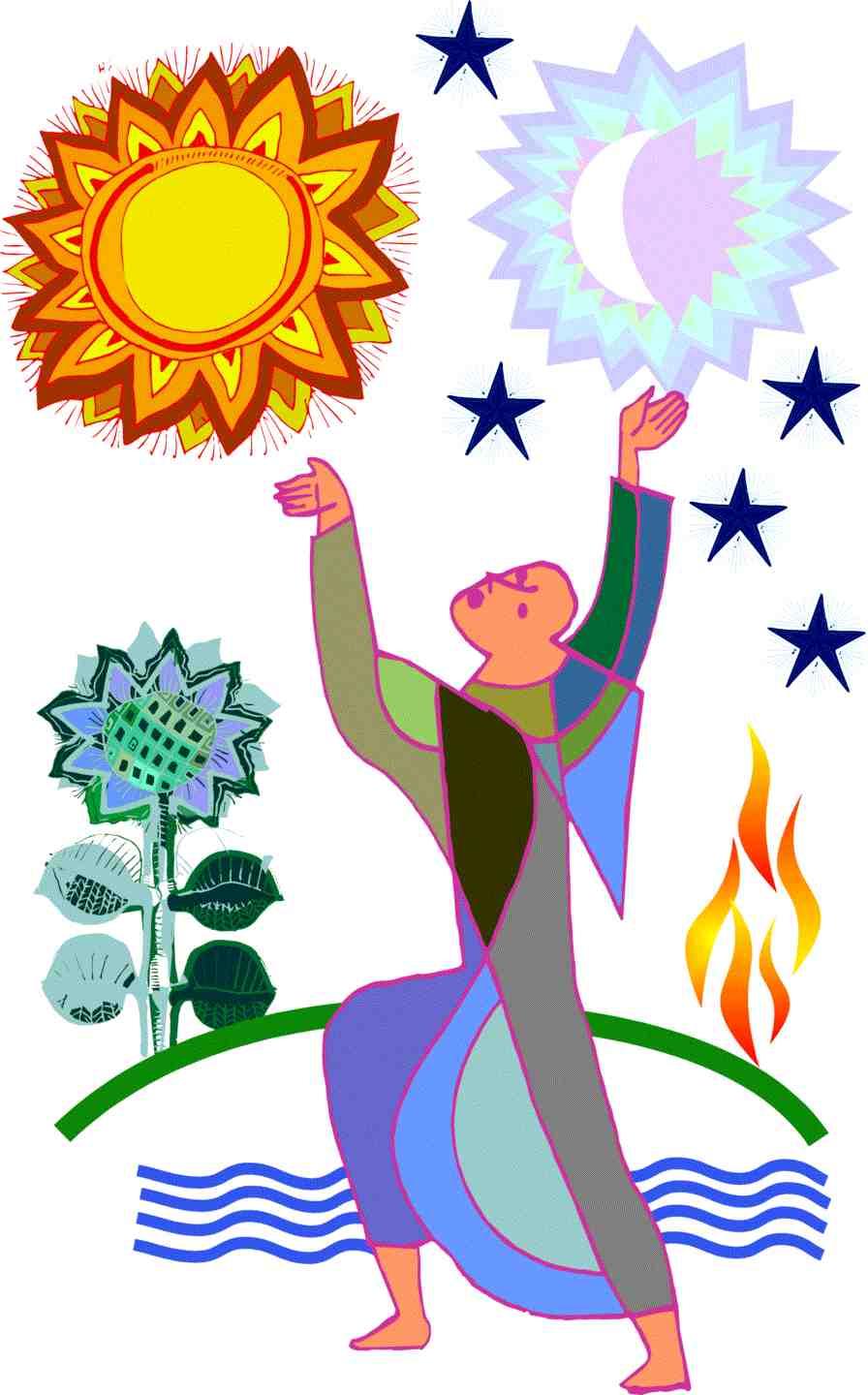
Introduction.
In the prior memoirs chapter “Another ‘Near Death’ Experience?”, I told of my miraculous survival and healing from critical taxicab rundown injuries, which I have attributed to the prayers, care, and good wishes of saints and many others who wanted me to get well. And I explained how the shock and trauma of my sudden injuries left me with continuing retrograde amnesia, without memory of what happened immediately before and after the taxicab incident, and while I was comatose.
In this chapter I will recount how a spontaneous act of loving-kindness by an ICU nurse – who synchronistically shared my reverence for Saint Francis of Assisi – proved an unforgettable healing blessing. I cannot remember the nurse’s name (so I’ll call her “Mary”), but my memory of our meeting was rekindled by an unforgettable document she left while I slept the next day; and I will never forget how I’ve felt because of her kindness.
A Holy Encounter.
For many years I have had frequent synchronistic meetings with strangers with whom I have experienced deeply harmonious connections. I have called them “holy encounters”. This is the story of an especially memorable holy encounter with a compassionate nurse which happened at the San Francisco General Hospital Intensive Care Unit [ICU], shortly after I had been run down and critically injured by a taxicab.
I have no memory of my admission to the ICU or of any prior conversations, diagnostic procedures or medical examinations there, and I was unaware of details of my injuries until after this encounter.
I later learned from medical records and from those who had examined or visited me that I had sustained a traumatic bleeding brain contusion and concussion, with extended loss of consciousness; large 2” chronic subdural hematoma pushing brain out of normal alignment; multiple fractures, including multiple facial fractures, bruises and lacerations; a fractured right leg tibial plateau; and various traumatic internal injuries, including a lacerated and bleeding liver. I was told that my head and face were completely bruised, discolored and swollen.
On the morning of this holy encounter I can now remember awakening supine on my hospital bed unable to rotate my body because of an IV tube and a full leg brace on my right leg. Presumably I was under influence of narcotic pain suppressant drugs which had been administered while I was unconscious, and until I was later able to decline them with informed consent.
Soon after I awakened that morning, I was greeted by a lovely slender, blond haired ICU nurse, who said:
“Good morning Mr. Rattner, I’m Mary your nurse for today.
How are you feeling?”
Amazingly, I simply responded:
“I’m grateful to be alive!”
Surprised, Mary commented appreciatively about my positive attitude. Whereupon I promptly recited for her my Silly Sutras saying that:
“An attitude of gratitude brings beatitude.”
And I explained to Mary that my attitude of gratitude came from abiding faith in Divine Providence, and conviction that I was blessed by Saint Francis of Assisi and other saints [*See Footnote]. Mary then told me that she had been raised to revere Saint Francis by her mother who regularly prayed to him at a home shrine.
Inspired by this wonderful synchronicity, I gladly recited for Mary the
“make me an instrument of Thy peace” prayer associated with Saint Francis, which amazingly I readily remembered, and which apparently she deeply appreciated. We talked briefly and she then proceeded on her rounds.
An unforgettable “get well” message.
The day after our ‘holy encounter’, I awakened to discover that while I slept Mary had placed this “get well” message, with the peace prayer of Saint Francis of Assisi, next to my bed.
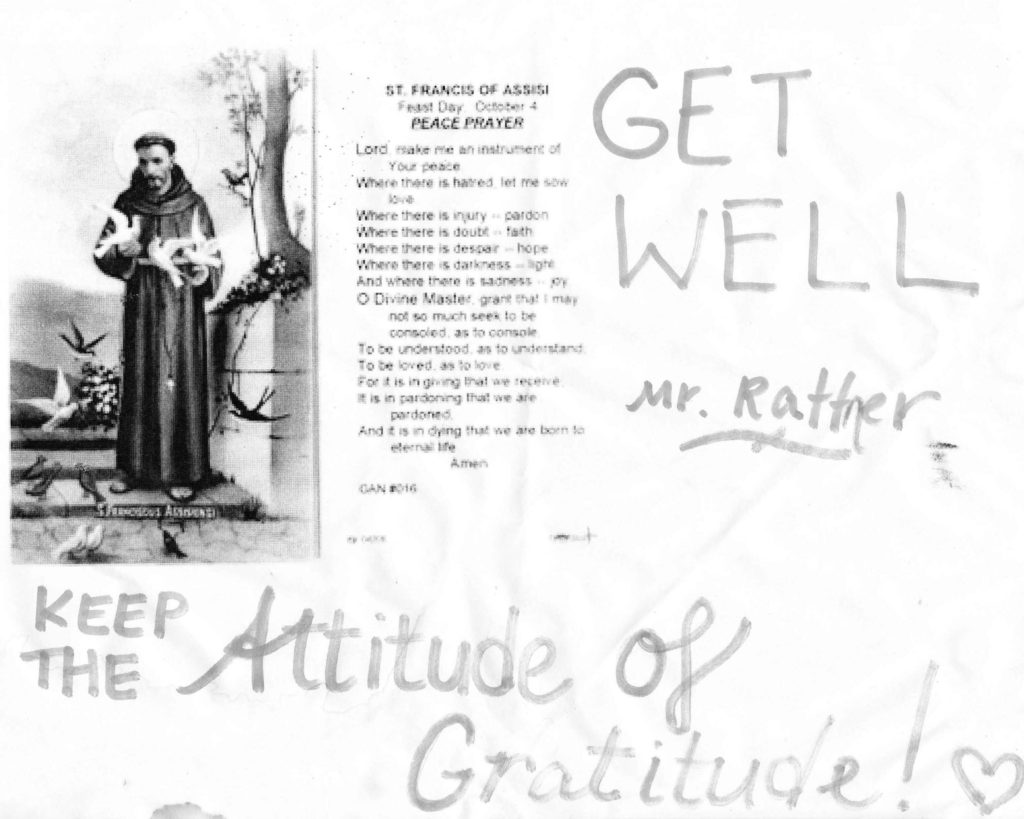
Conclusion.
I have heretofore told how my mid-life spiritual epiphany opened an emotional flood-gate which had been closed since childhood, and unleashed for the first time in my adult life an intense and unprecedented torrent of tears; how for many years I cried so often and so profusely that I came to realize that I was experiencing a great transformative blessing recognized in various devotional spiritual traditions, and which in the Catholic tradition of St. Ignatius of Loyola and St. Francis of Assisi was known as “the gift of tears”.
Though never a frequent flyer, I became – and for over forty years have remained – a very frequent crier. Tears have helped purify my psyche, body and nervous system permitting ‘peek experiences’ of higher states of consciousness, as well as many experiences of extreme ecstasy. They have become for me a divine sign of an opened heart.
Mary’s ‘get well’ message has consistently and often sparked a flood of heartfelt emotions and tears as it reminds me of our holy encounter and of my attitude of gratitude for this precious human lifetime. Thus, many times while writing this story I have cried with heartfelt gratitude.
Moral of the story.
Every spontaneous and heartfelt act of loving-kindness bestowed in ordinary life – even in seemingly insignificant incidents – can prove a lasting blessing for its recipient and everyone everywhere.
And so may it be!
Ron Rattner
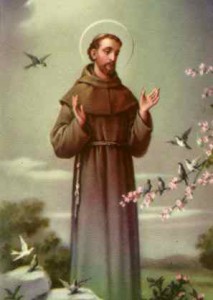
Footnote
* Saint Francis of Assisi.
Shortly after a profound spiritual opening in 1976, I began having synchronistic inner and outer experiences concerning Saint Francis of Assisi, of whom I was previously ignorant. Because of those experiences I developed deep affinity with this legendary saint, and regarded him an archetype to be emulated. Soon I began multiple daily recitations of the “make me an instrument of Thy peace” prayer associated with him, which have continued until now.
On retirement from legal practice in 1992, I made a pilgrimage to Italy to honor Saint Francis. In spring 1992, I journeyed to the Umbrian town of Assisi, Italy, where Saint Francis (‘Francesco’) was born and resided for most of his inspiring life, and where I experienced an extraordinary feeling of déjà vu, and some of the most memorable spiritual experiences of this lifetime. Also I made a magically memorable excursion to Mount La Verna in Tuscany – where Francis became the first Christian saint to receive the crucifixion stigmata of Christ. (See https://sillysutras.com/pilgrimage-to-assisi-communing-with-saint-francis-rons-memoirs/)
Know Death to Know Life;
Know Death to Know That
There is No Death
“Death is truly part of life … ‘what we called death is merely a concept’.”
“This happens at the gross level of the mind.
But neither death nor birth exist at the subtle level of consciousness that we call ‘clear light.’”
~ H.H. Dalai Lama, citing Tibetan Book of the Dead.
“Everything is changeable, everything appears and disappears; there is no blissful peace until one passes beyond the agony of life and death.”
~ Gautama Buddha
“And it is in dying [to ego life] that we are reborn to eternal life.”
~ St. Francis of Assisi, peace prayer, edited by Ron Rattner
“Normally we do not like to think about death. We would rather think about life. Why reflect on death? When you start preparing for death you soon realize that you must look into your life now… and come to face the truth of your self.
Death is like a mirror in which the true meaning of life is reflected.”
~ Sogyal Rinpoche
“Birth and death are virtual,
but Life is perpetual.”
~ Ron Rattner, Sutra Sayings
“As we lose our fear of leaving life,
we gain the art of living life.”
~ Ron Rattner, Sutra Sayings
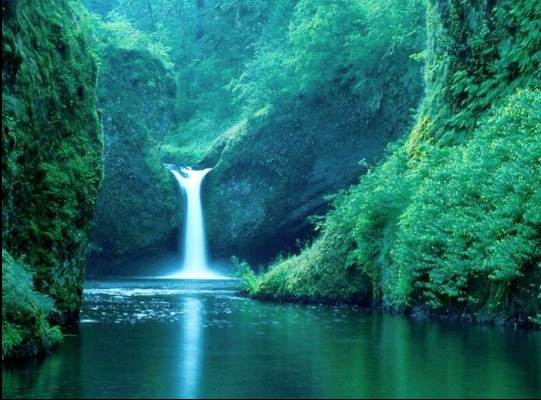
Know Death to Know Life;
Know Death to Know That There is No Death.
In phenomenal polarity reality
the idea of life, implies the idea of death.
All that appears disappears.
So, to live and to know earth-life,
we must experience and know earth-death.
But to Know and to Be that Consciousness
which is eternally aware of both earth-life and earth-death,
is to know that, beyond all appearance and disappearance,
There is no death –
only THAT which Knows.
So, to truly know Life
is to Know Death.
And to truly know death
is to Know that there is no death.
Ron’s audio recitation of “Know Death to Know Life; Know Death to Know That There is No Death”.
Ron’s Commentary on Knowing Death to Know Life.
Dear Friends,
Most Silly Sutras postings are dedicated to helping raise our spiritual consciousness, and thereby to enabling us to live happier lives, both individually and societally. Paradoxically many such postings intended to help us live happier lives, address death and dying.
Enduring religious and spiritual traditions reveal that “our deepest fears hide our highest potentials”, and that “as we lose our fear of leaving life, we gain the art of living life.”
So to help us transcend our fears of death and dying, I have today posted the foregoing poem Know Death to Know Life; Know Death to Know That There is No Death, plus an excellent embedded video documentary “The Tibetan Book of the Dead”, narrated by poet Leonard Cohen, together with its narrative text, which includes this key insight:
Physical death is inevitable and natural. But most people fear death, believing it ends life.
Thus, in much of American society dying is largely a taboo subject, with euphemistic and sorrowful language used to describe death and dying. And Americans usually die in hospitals or other institutions, and not at home surrounded by loved-ones. In the current extraordinary 2020 coronavirus pandemic era, billions of people worldwide seriously suffer from fear of death or disease, and loved-ones are often prevented from being with and consoling sick and dying people.
For millennia traditional societies have recognized physical death as an inevitable part of life, and have evolved elaborate traditions and teachings about death. For example, ancient Egyptians and Tibetans have codified such teachings in ‘Books of the Dead’. My beloved Guruji, Shri Dhyanyogi Madhusudandas, ran away from home at age thirteen in search of experiential answers to the interrelated perennial questions of “Who am I?” and “What is death?”.
The Tibetan Book of the Dead documentary video embedded below can help us transcend fear of death and dying. It was produced by NHK Japanese TV, and includes statements by the Dalai Lama, and authentic footage of Tibetan death teachings and practices in Ladakh. Whether or not you watch it, I recommend you read the posted narrative which is eloquently expressed in the film by poet Leonard Cohen.
Invocation
May these teachings about death and dying
help enable us to live ever happier lives,
both individually and societally,
as we lose the fear of leaving life, and gain the art of living life.
And so shall it be!
Ron Rattner
NHK documentary “The Tibetan Book of the Dead”, narrated by Leonard Cohen.
Documentary Narrative*.
Although everything on Earth seems stable and solid, nothing here is permanent. Like water, snow and ice, life is always shifting and changing form. All existence is one kind of state or another. This means living in an atmosphere of uncertainty – moving without a place to rest.
In this world, we pass through the spiritual state of physical existence. Here, we want to make something lasting and secure, but no one has been able to accomplish this. Our life is always in the hands of death. At death, our experience is completely out of our control. Our experience is completely naked.
What is the best path through this spiritual state? It is a question of waking up right now, looking at our own mind. Look at it when it is calm and still and when it is running wild. This is what Buddha did and what he taught. This is what Jesus meant when he said, “The Kingdom of God is within you.”
Soon we all will die. All our hopes and fears will be irrelevant.
Out of luminous continuity of existence, which has no origin and which has never died, human beings project all the images of life and death, terror and joy, demons and gods. These images become our complete reality. We submit without thinking to their dance. In all the movements to this dance, we project our greatest fears on death and we make every effort to ignore it.
Illusions are as various as the moon reflecting on a rippling sea. Beings become easily caught in the net of confused pain. We must develop compassion as boundless as the sky so that all may rest in the clear light of our own awareness.
At death, we lose everything we thought was real. Unless we can let go of all the things we cherished in our life we are terrified. We cannot stop struggling to hold on to our old life. All our fear and yearning will drag us into yet another painful reality.
We are always wandering through transitional spiritual states. Difficulty in leaving behind our old life can cause us to wander in painful uncertainty.
The spiritual state of dying lasts from the beginning of the body’s physical collapse until the body and consciousness separate.
While we are living, the elements of Earth, water, fire and air together support and condition our consciousness. Death occurs when this is no longer the case. Now, without the screens and filters of daily life, at this time, mind itself can be seen directly. In the spiritual state of dying, it is important to recognize our own true nature.
At death, there is an experience of piercing luminosity, pure white light, the clear radiance that rises directly from our own basic nature. Now, there is no darkness, no separation, no direction and no shape, only brilliant light. This boundless sparkling radiance is mind, free from the shadows of birth and death – free from any boundaries of any kind.
Now all pervasive light engulfs us completely. All of space is dissolved into pure light. This radiance is the mind of God, the mind of all the awakened ones. Recognizing this is all that is necessary for liberation from birth and rebirth. If we do not recognize our divine nature, a dreamless sleep will happen.
In three days time, all emotions will be vivid and intense. Though it seems we are entering into a new reality, it is still the reality of our own mind.
Wandering back to the familiar sites and people of our old life, our own mind will arise before us in unfamiliar ways. We may not know if we are alive or dead. Even so, we may see our family crying. We must leave our former life behind if we are to progress.
If the we are unable to recognize the luminosity of mind itself, our experience now takes the shape of random imagery of our former life. We see our friends and relatives calling out to us and they cannot hear our replies. Death has cut us off from them and sorrow strikes our heart. We see our family and relatives crying. We can see our bed but we are no longer the one lying there. Instead, there is a corpse.
Soon we will experience the intense presence of our own emotional states as peaceful and raging light forms. Now, we will meet our mind in the form of projections which seem vivid and entirely real. Now we will see penetrating blue light shining all around us. This is the essence of consciousness, God (Buddha). The wisdom of God is like a mirror reflecting everything. God is the form of consciousness in its complete purity. This wisdom is inseparable from our own heart. But also we will see a diffused white light which we must avoid if we are to achieve liberation. If we follow the allure of the soft white light, we will find ourselves ensnared in the temporary pleasures of being born as a god, living in Lordly ignorance of the passage of time and subject to unexpected death.
If this path is taken, the wisdom of our very heart and mind takes the form of spiritual entities. There will be peaceful spiritual entities that emanate from our heart and wrathful ones that emerge from our brain.
They will appear one by one and then all together. The peaceful spiritual entities are complete and immovable. If we cannot bear to enter their vast benevolent space, if we cannot let go of self-centeredness and fear, these deities will become terrifying wrathful ones. If we recognize them as an expression of our own mind, they are the unsparing face of wakefulness.
The wrathful forms emerging from the brain appear before us actually and clearly as if they were real in their own right. The terror and anger we feel are our own efforts to evade from being completely awake. We wander uncertainly in the landscape of our own mind. If we recognize this as our own projections, liberation is instantaneous.
These wrathful forms are the presence of our innate wisdom, the vivid form of our own wakefulness. We must recognize them as a reflection of our own mind. Recognition and liberation are simultaneous.
All of us feel sparks of anger, flickers of passion, and twinges of jealousy during brief moments. From these seeds, we grow to become the jealous person. We say “this is what I am” and we act accordingly. But these are just our masks and we forget that we are wearing them. We run from the masks that others wear. The wrathful spiritual entities are our own mind and it is impossible to run away from them. They are the sharpness of our own clarity. They are all in our mind.
Then altogether and all at once, the peaceful and wrathful spiritual entities come before us. If we do not recognize them as our own projections, then they transform into the terrifying image of the Lord of Death. This too is our own projection. But if we don’t accept that, our fear and turmoil force us to wander on in terror to the spiritual state of rebirth. We leave the spiritual state of the nature of mind. Again we are lost and wandering, so now we seek to end our suffering by being born into a solid and familiar place.
Now in the spiritual state of rebirth, all our senses have become extremely acute. Our consciousness is like a body without substance. In this body, we can, by a mere thought, travel to anywhere. As if we have miraculous powers, we can pass through mountains and circle the universe. We can enter anywhere but nowhere can we rest.
In the pain of our endless wandering, the thought of being born now promises great relief. We can still see our family, but we no longer know we are with them. We are driven on the winds of hope and fear like a leaf that is carried in the wind.
If we are still unable to recognize our own nature, our anger, lust and confusion become ever more intense, ever more solid. They at last appear to us as entire realms where we may stop and dwell. The image of our former body becomes faint and the image of our future body becomes clear. Any birth seems better than his current pain.
Since everyone is caught in these spiritual states of suffering, what can we do? People make hell realms out of their own anger. They make worlds out of passion. We project our emotional states and believe it is the real world. But no matter what, everyone longs for compassion. Everyone wishes to be awake. The best thing is to develop genuine compassion for all living things and for ourselves too. If we do not truly care for others we cannot know our own mind. We can have lofty insights and pure impulses, but then return to our old habits without even noticing it. We must work all the time to open our hearts and look for the truth. Otherwise there is neither understanding nor a purpose for understanding. Also, as life goes by, it is a good idea to keep your sense of humor.
We are now coming to the end of our journey. As we reach the end of the spiritual state of rebirth, the features of the world we are to enter will become very clear to us. If we pay attention now, we will find our way to a favorable rebirth.
We are now on the path to rebirth. We must choose carefully where we are to be born. In all the possibilities that are present before us, we must choose our new life. If we choose a good human birth in a good place, we can continue on the path of recognizing our own mind. Even though we are desperate for a home, a dark cave in a forest can lead to a birth in the animal realm. If we are consumed by yearning, the realm of hungry ghosts can become a never-ending realm of hunger and thirst for us. Rage, bitterness, and anger open all the images of hell. It is best to avoid the extremes of pleasure or pain when selecting a new birth. It is best to be born where we can still recognize the luminous essence of our own mind.
We will not remember much of our journey when we are born again. It will be like starting out new. Though death is always something to be mourned, being born is not something to be celebrated. There is an old saying: “When we are born, we cry, but the whole world is overjoyed. When we die, the world cries and we can become overjoyed when we find the great liberation.”
*Source: Kevin Williams, http://www.near-death.com/religion/buddhism/commentary.html
Hydrologic Logic:
What People Can Learn From Snowflakes
“Be melting snow.
Wash yourself of yourself.”
~ Rumi
“Love is the water of life,
jump into this water.”
~ Rumi
“To understand water is to understand the cosmos,
the marvels of nature, and life itself.”
~ Masaru Emoto
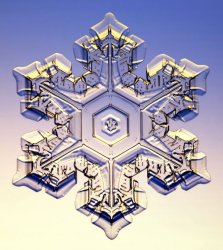
Hydrologic Logic: What People Can Learn From Snowflakes
Perennial wisdom says we can learn about ourselves by closely observing all of Nature’s manifestations and processes.
“As above, so below; as below, so above.”
~ The Kybalion, Hermetic axiom
“Look deep into nature, and then you will understand everything better.”
~ Albert Einstein
So, what can we learn about ourselves by studying snowflakes and hydrologic processes?
Science tells us that though countless trillions of snowflakes have fallen on earth each has a unique form; that each snowflake is an hexagonally symmetrical crystalline form which begins around a tiny speck of dust – as each pearl forms around a sand particle – but that no two snowflakes are exactly alike.
How amazing!!! http://www.its.caltech.edu/~atomic/snowcrystals/faqs/faqs.htm
Yet, despite this wondrous and unimaginable diversity of forms, all snowflakes have a common essence – frozen water – H20.
When a snowflake melts, it returns to and merges with its watery source, which is perpetually recycled. So, each snowflake’s essence is the same – recycled water, which has formed countless unique prior snowflakes.
Not only do miraculously unique snowflakes originate from their common watery essence, but science says that such essence is indestructible. Water – a liquid – is a form of ‘matter’ which is merely manifest energy: E=mc2. And energy can’t be destroyed. It just recycles endlessly from formlessness to differing forms and phenomena. So, in their essence, snowflakes are immortal energy.
People are like snowflakes
Like miraculously unique snowflakes, each of the countless humans who has inhabited Earth has had a unique form and genetic makeup. Like snowflakes, human physical bodies are composed of common elemental earth constituents, including mostly water. People’s physical bodies – like snowflakes – appear for a twinkling of time, die and ‘melt’ back into the watery Earth.
But, presumably unlike snowflakes, each of us is aware of our environment and of our life’s experiences; and this awareness is our entire existence. So, while unique snowflakes are united in glorious diversity by their common watery essence, physically unique human beings, are unified not only by their common elemental earthly constituents but, also, by their by their common essence – consciousness, which is the sole context of human beingness.
Snowflakes appear in Nature and, apparently, are peacefully at one with Nature until they disappear. Humans appear in Nature but – unlike snowflakes – we have great intelligence and we think a lot. And through thought we identify ourselves as our perceived separate forms. Thus, we think that we are entities “condemned” by nature to inevitable bodily death. But we don’t know what will happen to us upon such death.
So, we become afraid of dying; of giving up the known for the unknown. And, through thought, we try to “protect” and preserve our ephemeral physical forms and to deter or psychologically deny their inevitable demise. Accordingly, our lives are often marked by mental afflictions causing conflicts, problems and suffering, which disturb our peace and awareness of at-one-ment with Nature.
What people can learn from snowflakes
Q. So, what can people learn from snowflakes?
A. To let go and ‘go with the flow’; to ‘cool it’ and to not worry about our inevitable disappearance.
We can realize that we are much more than our unique physical forms, or our thoughts. That like snowflakes we are inextricably interdependent essential elements of Nature; that Nature is our nature, until we melt into Mystery and disappear into Nature’s Eternal Essence.
Realizing this, we can begin more and more to self-identify with Nature as our immortal Essence rather than with our ephemeral forms and thoughts; and, gradually, we can expand our perceived boundaries, to ever evolve as these boundaries dissolve.
Thus, we can more and more live with less and less anxiety, fear and worry. Though in this life we may never totally transcend entity identity, often we can just be at peace – as immortal awareness.
And so,
“As we lose our fear, Of leaving life, We shall gain the art of living life.”
And – like snowflakes – maybe some day we’ll be ‘recycled’ some way. e.g. http://www.victorzammit.com/Whenwedie/whatdoeshappen.htm
Or maybe not. e.g. http://tinyurl.com/mlw6erq
In all events, – like snowflakes – we need not worry about leaving. For
“It is in dying [to ego life] that we are reborn to Eternal Life.”
~ Saint Francis of Assisi, peace prayer
Conclusion
People can learn from snowflakes to let go and go with Nature’s flow, until we become immortal; we can learn that
“Life is a series of natural and spontaneous changes. Don’t resist them; that only creates sorrow. Let reality be reality. Let things flow naturally forward in whatever way they like.”
~ Lao Tzu
And that:
“The dewdrop belongs to the sea. Separated, it is vulnerable to the sun and wind and other elements of nature; but when the droplet returns to its source, it becomes magnified in oneness with the sea. So it is with your life. United to God you become immortal.’
~ Paramahansa Yogananda
So, as elements of Nature, we need not worry, and can be happy and peaceful as we melt into our immortal Source – like snowflakes!
Namaste!
Ron Rattner
Hydrologic Logic Epilogue, May, 2020, Honoring Dr. Masaru Emoto .
Dear Friends,
In recent messages and postings I’ve optimistically opined that the current coronavirus pandemic emergency has given us an unprecedented opportunity to co-create a new and wonderful world of happiness, harmony and health for everyone everywhere. And I’ve tried to suggest how that can happen, if we follow our hearts, instead of being paralyzed by propaganda provoked fear and panic.
Did you know that the Earth is 70 percent water, and that people are 70 percent water; and, that according to NASA, “Water is the fundamental ingredient for life on Earth” ?
The foregoing essay was originally inspired by the ancient hermetic axiom, ‘as above, so below’ and by advice of my Guruji and other wisdom teachers to learn from Nature. Later in 2004, via the film “What the Bleep Do We Know?”, I was deeply impressed on discovering the pioneering research of Dr. Masaru Emoto whose astonishing discoveries, documented photographically, have led to awakened awareness about water as Earth’s most precious resource.
Dr. Emoto discovered that molecules of water are affected by our thoughts, words, and feelings, so that that humans can positively impact the earth and our personal health through loving, grateful and harmonious attitudes and actions, especially with attention to water; that since the Earth is 70 percent water and people are 70 percent water, he theorized that we can heal our planet and ourselves by consciously expressing love and goodwill to and through water.
He explained and demonstrated that crystals formed in frozen water reveal changes when specific concentrated thoughts are directed toward them; that water from clear springs and water that has been exposed to loving words shows brilliant, complex, and colorful hexagonal snowflake patterns, whereas polluted water, or water exposed to anger or other negative thoughts, forms incomplete, asymmetrical patterns with dull colors.
Also Dr. Emoto described the ability of water – like a liquid computer – to absorb, hold, and even retransmit human feelings and emotions. Using high-speed photography, he found that crystals formed in frozen water reveal changes when specific, concentrated thoughts are directed toward it. Music, visual images, words written on paper, and photographs also have an impact on the crystalline structures. These methods even experimentally worked on asymmetrical Tokyo tap water. Dr. Emoto theorized that since water has the ability to receive a wide range of frequencies, it can also reflect the universe in this manner.
Especially in these unprecedented times of worldwide pandemic panic when insanely delusional human behaviors imminently threaten Earth-life as we have known it, we have unprecedented opportunity to gratefully and lovingly cherish and harmoniously heal our precious watery world, which appears blue from outer space, and was thus eloquently described by legendary astronomer Carl Sagan as a “pale blue dot” in this vast universe.
Invocation
Instead of being paralyzed by fear and panic, may we follow our hearts, rather than unfounded official edicts, to collectively and cooperatively realize an abiding “new normal” era of cooperation, harmony and peace on our precious planet.
So let us gratefully and lovingly be guided by these wise words from Paramahansa Yogananda:
“Every day should be a day of Thanksgiving for all the gifts of Life — sunshine, water, the luscious fruits and greens, which we receive as indirect gifts from the Great Giver.”
“Affirm divine calmness and peace, and send out only thoughts of love and goodwill if you want to live in peace and harmony.
Never get angry, for anger poisons your system.”
And so shall it be!
Ron Rattner
“The Secret Life of Water”
Embedded below are three brief videos:
A memorable two minute scene from “What the Bleep Do We Know?”;
A one minute+ video showing hexagonal crystals forming in Tokyo tap water;
And a beautiful nine minute video with healing music, watery photography, and with words from Dr. Emoto titled “The Secret Life of Water” . ENJOY!
Life is For Giving
“For it is in giving that we receive.”
~ St. Francis of Assisi, peace prayer
“You give but little when you give of your possessions.
It is when you give of yourself that you truly give.” …
“For in truth it is life that gives unto life –
while you, who deem yourself a giver,
is but a witness.”
~ Kahlil Gibran, The Prophet
“You can give without loving,
but you can never love without giving.”
~ Robert Louis Stevenson and/or
~ Victor Hugo, Les Misérables
The value of a man resides in what he gives
and not in what he is capable of receiving.
~ Albert Einstein
The wise man does not lay up his own treasures.
The more he gives to others, the more he has for his own.
~ Lao Tzu
It’s not how much we give
but how much love we put into giving.
~ Mother Teresa
“If you wish to experience peace,
provide peace for another.”
~ Tenzin Gyatso, The 14th Dalai Lama
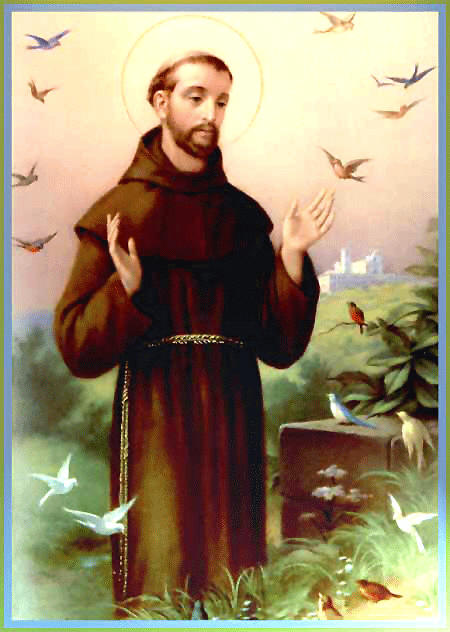
St. Francis of Assisi
Life is For Giving
Life is for giving, not getting;
For Being, not having.
Love gives and forgives.
Ego gets and forgets.
It is in giving that we receive.
So, let us end our obsession with possession,
And live to give, and to be –
LOVE.
Ron’s audio comments and recitation of “Life is For Giving”
Ron’s Commentary on Giving Not Getting:
Dear Friends,
For many years I have regularly recited [with amendments] the peace prayer of Saint Francis of Assisi, declaring in conclusion that:
“it is in giving that we receive; it is in pardoning that we are pardoned;
and, . . it is in dying – to ego life – that we are reborn to Eternal Life”.
Those oft-repeated lines have inspired many of my writings, including the above “Life is For Giving” poem. In the above posted quotes about giving, I have excerpted these lines from Kahlil Gibran’s perennial wisdom in “The Prophet”:
“You give but little when you give of your possessions.
It is when you give of yourself that you truly give.”
“For in truth it is life that gives unto life –
while you, who deem yourself a giver, is but a witness.”
~ Kahlil Gibran, The Prophet, “On Giving”
As we consider and reconsider those wisdom quotes and prayer lines, more and more it seems that each human lifetime is part of a cosmic process of transcending ego’s optical illusion of our imagined separation from each other, and from our true spiritual nature; a mysterious process of our returning psychologically to a state of “At-one-ment” and self-identity with Universal Intelligence or Awareness, as our ultimate Essence and our ultimate destiny.
In that evolutionary process, as we transcend mistaken ideas of who we think we are, we gradually realize what we truly are. We learn that apparent separation of ‘giver’ and ‘receiver’, or ‘pardoner’ and ‘pardoned’, or ‘I’ and ‘others’, is a persistent perceptual delusion – like a mirage.
And we find that by spontaneously giving of ourselves and forgiving others with LOVE our spiritual Self-awareness process is furthered, bestowing ever-more fulfilling life experience.
Today’s writings about giving and forgiving are offered with the aspiration they will help us realize – like Kahlil Gibran – that “it is life that gives unto life”, not “I” or “me” giving to others. And that we may so live ever happier lives.
And so may it be!
Ron Rattner
A Day of Grace: Rediscovering the Porziuncola ~ a Synchronicity Story
“Every feature of the Porziuncola lifts the heart and mind to God”
~ St. Padre Pio
“The winds of grace are always blowing, but you have to raise the sail.”
~ Sri Ramakrishna
Above all the grace and the gifts that Christ gives to his beloved is that of overcoming self.
~ Francis of Assisi
“The deeds you do may be the only sermon some persons will hear today”
~ Francis Of Assisi
Remember with gratitude,
Life is beatitude –
Even its sorrows and pain;
For we’re all in God’s Grace,
Every time, every place, and
Forever (S)HE will reign!
~ Ron Rattner, Sutra Sayings
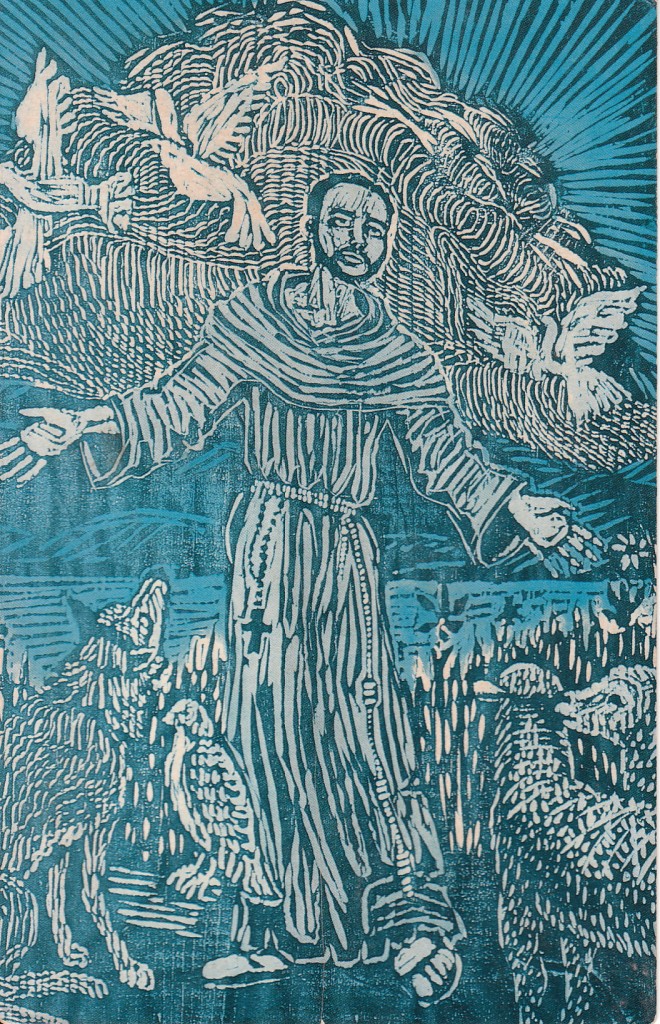
Saint Francis of Assisi by Lea Bradovich
A Day of Grace: Rediscovering the Porziuncola
When I moved from Chicago to San Francisco in 1960, I was largely uninformed about religions other than Judaism, and knew virtually nothing about saints. Even though Saint Francis of Assisi was patron saint of my new home, I remained ignorant of his life story until after my profound spiritual opening in 1976.
Then, through a series of synchronistic inner visions and outer events I developed a deep inner rapport with Saint Francis. And his prayer became – and remained – an important part of my daily spiritual practice.
On retirement from law practice in 1992, I made pilgrimages to India and Italy to pay my respects both to my spiritual master Dhyanyogi Madhusudandas and to Saint Francis.
On arriving in Italy in Springtime 1992, I rented a car at the Rome airport and drove northward to the Umbrian town of Assisi, where Francis was born and resided for most of his extraordinary life. As I arrived at the outskirts of Assisi, I immediately experienced a remarkable feeling of déjà vu, and was so overcome with emotion that I had to pull over to the side of the road as I began crying deeply and intensely for a long time.
My subsequent stay in Assisi and excursion to Mount La Verna in Tuscany – where Francis became the first saint to receive the crucifixion stigmata of Christ – proved magical, with unforgettable spiritual experiences.
One of the most profound of those experiences happened as I visited a tiny frescoed chapel called Porziuncola [“the little portion”]. It had been restored from a ruined condition by Francis and his early followers to become first home of the Franciscan order. Here, Francesco lived, wrote his rule, created his order of friars minor and consecrated his friend Clara (Chiara), who became Santa Clara, founder of a female order dedicated to Franciscan ideals of holiness and poverty. Francis so loved this little place that he chose to die there.
As I entered the Porziuncola at Assisi, I experienced a palpable aura of love and was overcome with emotion, cried deeply and intensely and lost track of time. Ever since then, a memory of that exquisitely simple little chapel and its aura of supernal Love has remained enshrined in my heart. Although I have never since returned that holy Assisi place, which Saint Francis named and loved, my cherished memory of the Porziuncola was revived following a surprising and synchronistic ‘holy encounter’ in San Francisco, almost twenty years later. Here’s what happened.
After retirement many years ago, it became my practice to walk almost daily along San Francisco Bay. Most often I walked to the Bay following pedestrian paths beside the Fort Mason Great Meadow, which is part of the Golden Gate National Recreation Area (GGNRA), our nation’s newest National Park.
As I arrived at Fort Mason on a beautiful and sunny June morning, I was obliged to detour from my usual path to the Bay. The National Park Service had closed the pedestrian paths around the Great Meadow for repaving. So to reach the Bay I had to walk across the grassy meadow. There I saw a very unusual sight. Perhaps hundreds of children, attended by mostly senior adults, many dressed in white, were gathered in the meadow. Many tents were set up for children’s activities, such as face painting and fortune telling. Sweet music was playing on loud speakers.
I was quite impressed by this charming scene, of sweet children and caring adults, and I sensed an especially loving atmosphere pervading the meadow. Curious, I asked the first chaperone I encountered, “what’s happening?”. A lovely senior lady told me that this was a children’s fair sponsored by the Meher School of Lafayette (a San Francisco suburb) for its students and for children from less affluent San Francisco neighborhoods, who had also been invited. [*see footnote]
Inspired by the love I perceived and felt there, I continued walking through the meadow and toward the Bay. After hiking out to the end of San Francisco Municipal Pier, I began returning home. Soon, I noticed an unopened bottle of spring water apparently dropped by a cyclist. I picked up the water bottle, determined to give it to someone at the children’s festival in the Great Meadow.
As I arrived again at the meadow, I was met by a tall friendly (and thirsty) man named Peter, who seemed to be watching out at the perimeter of the children’s gathering. Though we’d never met, he somehow seemed familiar. In greeting me Peter asked, “would you like to know what’s happening?” After I recounted what I already knew about the festival and gladly gave Peter the bottle of spring water, he told me more details of this event.
Peter explained that this gathering was like a mini-Umbrian children’s festival inspired by universal values of Saint Francis of Assisi which are similar to those of the Meher School; and, that periodically the school sponsors a play about the life of Francis performed at various venues, including at The National Shrine of Saint Francis of Assisi, located in San Francisco’s oldest church in the North Beach district.
I was very surprised when Peter mentioned a national shrine of Saint Francis of Assisi located in San Francisco. Though I’d then lived in San Francisco more than fifty years, I don’t remember ever before hearing about such a national shrine. Moreover as Peter described the shrine, I was amazed to learn that it included an almost exact replica of the Porziuncola at Assisi, recently constructed at the instance of former San Francisco supervisor Angela Alioto.
Peter and I then exchanged stories about our respective springtime visits to Assisi and our heartfelt affinity with Saint Francis. On parting we shared contact information.
A few days later, I received an email invitation from Peter’s friend and colleague, Terry, to tour the San Francisco Porziuncola shrine, which I quickly accepted. Terry, was both music director of the Meher School’s sponsoring non-profit organization, Sufism Reoriented, and a member of the Knights of St. Francis, a volunteer organization which helps safeguard the national shrine.
The tour proved magical for me. With Terry and Peter as guides, I beheld for the first time the San Francisco “Porziuncola Nuova”. Before entering, I noticed carved in Italian on the second marble step a quote from Francesco: “Vi voglio tutti in Paradiso” [“I want you ALL in Paradise”]. On learning what those words meant, I experienced instant heart-felt emotion and tears.
As I entered the sanctuary that emotion deepened, and soon overcome by it I was obliged to sit silently in a pew, just as I did in Assisi. And, as in Assisi, profuse tears flowed. Unable to talk, I sat and cried for a while as Peter compassionately attempted to comfort me. In the San Francisco Porziuncola I didn’t lose track of time as I did in Assisi, and after crying for a while resumed conversation with Terry and Peter.
But I continued feeling so emotional in that sacred space that I was unable to focus on details of the beautiful pictorial art and artifacts around me, which I later observed on other visits.
I did however notice a prominently displayed letter Tau, the last letter of the Hebrew Alphabet which in biblical times closely resembled the letter T. [See below.] The Tau was adopted by Francesco as his own symbol or logo which he painted on the walls and doors of places where he stayed, and used in his writings as his only signature. (Synchronistically, I had a few days earlier been discussing with a friend possible use of a Tau as a logo for The Perennial Wisdom Foundation, the new non-profit corporation which I was then forming.)
Before exiting the “Porziuncola Nuova” I gazed upon and gently touched one of the holiest Franciscan relics in the world, a beautifully displayed rock believed to have been used by Francis as a crude tool in his reconstruction of the Porziuncola.
After departing the shrine, Terry and Peter and I adjourned for lunch in a nearby restaurant, where we shared stories of how Divine Grace has continuously blessed our lives, as it did on that magical day.
And in now reflecting on that wonderful day of rediscovery, I realize that it couldn’t have happened but for my synchronistic detours through the grassy Great Meadow and desire to share a bottle of spring water which I happened to find while walking by the Bay.
It seems that Divine Grace often works through synchronicity, and that the more alert we become to such synchronicity the more it happens.
What do you think?

Franciscan Tau
* I later learned that this children’s fair was part of an ongoing national program called Francis in the Schools founded in 2010 by Dr. Carol Weyland Conner, spiritual director of Sufism Reoriented.
Pilgrimage to Assisi : Communing With Saint Francis ~ Ron’s Memoirs
“All the darkness in the world cannot extinguish the light from a single candle.”
~ St. Francis Of Assisi (The Little Flowers of St. Francis of Assisi)
“If you have men who will exclude any of God’s creatures from the shelter of compassion and pity, you will have men who will deal likewise with their fellow men.”
~ St. Francis of Assisi
“The deeds you do may be the only sermon some persons will hear today”
~ St. Francis Of Assisi
Pilgrimage to Assisi: Communing With Saint Francis
Introduction
On moving from Chicago to San Francisco in 1960, I knew virtually nothing about saints and was largely uninformed about religions other than Judaism. Even though Saint Francis of Assisi was patron saint of my new home town, I remained ignorant of his life story until after my profound spiritual opening in 1976.
Then, about two years before meeting my Guruji, Shri Dhyanyogi Madhusudandas, I began having synchronistic inner and outer experiences concerning Saint Francis of Assisi, of whom I was previously ignorant. Because of those experiences I developed deep affinity with and great curiosity about this legendary saint, and regarded Saint Francis as an archetype to be emulated.
Soon I began and have ever since continued daily recitations of the “make me an instrument of Thy peace” prayer associated with him. But I was unable to satisfy my curiosity about Saint Francis until ten years after to my 1982 pilgrimage to India. Then on retirement from legal practice in 1992, I made pilgrimages to India and later to Italy to honor my beloved Guruji and ‘Francesco’.
In spring 1992, I journeyed to the Umbrian town of Assisi, Italy, where Saint Francis was born and resided for most of his inspiring life, and where I experienced an extraordinary feeling of déjà vu, like that experienced in India at the temple home of Shri Ramakrishna Paramahansa in 1982. My pilgrimage stay in Assisi and an excursion to Mount La Verna in Tuscany – where Francis became the first saint to receive the crucifixion stigmata of Christ – proved magical, There, with intense and tear-laden emotion of devotion, I was blessed with a few of the most memorable spiritual experiences of this lifetime, which I will hereafter recount.
Arrival at Assisi and Worshiping at Tomb of St. Francis.
I arrived at the Rome airport on a Spring evening in 1992. After sleeping that night at an airport hotel, the next morning I rented an auto and drove north toward Assisi. Instead of taking the fastest autostrada route, I elected a slower scenic route. After a few hours I came to a sign announcing that I was entering Assisi. Immediately after the sign there was a rightward road bend whereupon I beheld a vista of my intended destination – the beautiful Umbrian town of Assisi, where St. Francis was born and resided for most of his extraordinary life.
Almost immediately thereafter I was obliged to pull off the road, in a turnoff place.
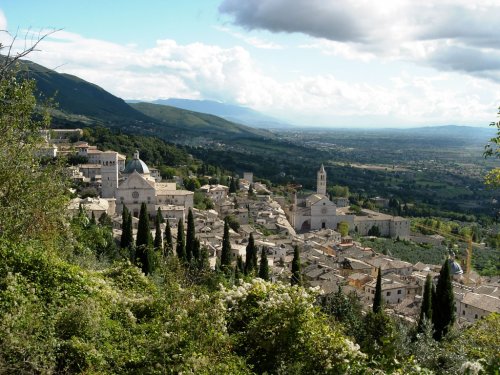
Assisi, Italy
I couldn’t drive further because I began crying spontaneously and intensely, with deep emotion sparked by a mysterious feeling of déjà vu that I had returned to a beloved and familiar place. Only after shedding many tears was I able to resume driving to my destination – the Ananda Spiritual Retreat Center in the Umbrian hills outside Assisi – where I stayed during my pilgrimage there.
The Ananda center had been founded by Swami Kriyananda, a prominent direct disciple of Paramahansa Yogananda, who in Autobiography of a Yogi referred to St. Francis as an “apostle of humility”. So, it seemed an ideal place for me stay as a “born-again Hindu” devotee of St. Francis.
According to Swami Kriyananda:
”St. Francis of Assisi was Paramhansa Yogananda’s “patron saint.” Yogananda had at least two visions of St. Francis that he spoke of — one during a visit to Assisi, Italy in 1936, and another at Mt. Washington that inspired his beautiful poem, “God, God, God.” Yogananda admired the renunciation and simplicity of St. Francis.”
After sleeping my first night at the Ananda center, the next day I drove into Assisi. With continuing déjà vu I walked through medieval streets of that lovely town experiencing a sweet and mysteriously familiar ambience. Then I visited the giant Basilica of Saint Francis, under which the great saint is entombed. Near the crypt containing his remains there were continuing Masses being celebrated consecutively in various languages for pilgrims from places worldwide.
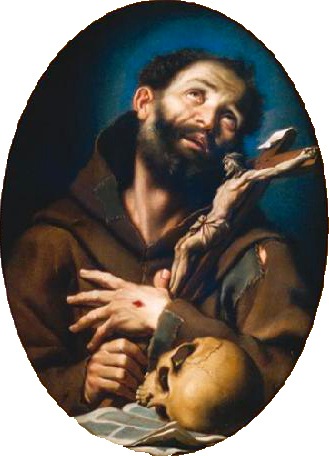
St. Francis of Assisi
As a secular Jew transformed to “born-again Hindu”, who spoke only English, I had never before participated in a Catholic mass. However, irresistibly I attended several consecutive masses in various languages which I didn’t understand. But my heart knew the pervasive sweet and familiar ambience which I had experienced outside the Basilica, and which had become intense for me near Franceso’s tomb beneath the Basilica. And I was compellingly drawn to it.
Eight hundred years after Saint Francis had walked in that lovely Umbrian town it seemed for me that it was everywhere still pervaded by his sweet life-force shakti; with its emanation being especially intense at the site of his entombed remains. Afterwards I unforgettably experienced that same familiar life-force emanation at other Assisi shrine places.
Hereafter I will tell you about three more memorable experiences of communing with the spirit of St. Francis in Italy.
Discovering the Porziuncola

Porziuncola within Basilica
One of the most profound of those experiences happened as I visited a tiny frescoed chapel outside Assisi called by Francesco Porziuncola [“the little portion”]. He and his early followers had restored it from a ruined condition to become first home of the Franciscan order. And it was Francesco’s favorite place on earth.
Here, he lived, fervently prayed, wrote his rule, created his order of friars minor and consecrated his friend Clara (Chiara), who became Santa Clara, founder of a female order dedicated to Franciscan ideals of holiness and poverty. Francis so loved this little place that he chose to die there.
In 1216, Francis had a legendary vision in the little chapel. After fervent and tearful prayers, a light filled the chapel and he saw above the altar Christ, the Virgin Mary and a company of angels. They asked him what he wanted for the salvation of souls. In response Francis requested that all those who might enter the chapel and contritely repent their sins be granted a pardon and remission of all such sins. Whereupon Francis was told by the heavenly host that his request was granted.
Thus, the Porziuncola was thereafter Papally blessed with “The Pardon of Assisi” so that those who enter and repentantly pray there are pardoned of their sins, and it has been proclaimed a ‘world holy place’.
Having paid respects to Saint Francis at the basilica where he is entombed, my next pilgrimage destination was the Porziuncola. But I went there unprepared for what I saw. In reading biographies of the saint I had focussed on his simplicity and humility and somehow missed description of the giant basilica which had enveloped his beloved tiny headquarters chapel.
I didn’t realize until then that by Papal order, three hundred fifty years after Francis’ death, the great Basilica of Santa Maria degli Angeli (Saint Mary of the Angels) was erected over the simple Porziuncola chapel – Franceso’s “little portion” – and that all its original outbuildings were demolished, except the simple cell where Francis died. So I felt a bit bewildered on approaching and entering the grandiose basilica – so inconsistent with Francis simple life and message – and wondered what he might say about it.
But I found my way to the tiny chapel which was situated directly beneath the basilica cupola. And after waiting in line with others, I was able to enter and sit in the tiny and simple Porziuncola. With renewed déjà vu, I immediately experienced an almost palpable aura of the saint’s supernal love, and spontaneously cried deeply and intensely. I was so overcome with emotion that I lost track of time.
On regaining my senses, I realized with a guilty conscience that I had overstayed my time there, while other pilgrims waited in line for a chance to enter, and perhaps to repent and be absolved of their sins. So in a highly “enshakticated” [love intoxicated] condition I slowly got up and walked out. With continuing déjà vu I strolled to the place there where Francis died on October 3, 1226. Then, still in an altered state of awareness, I returned to the Ananda center after one of the most memorable experiences of this lifetime.
Memory of that exquisitely simple little chapel and its aura of supernal Love has remained enshrined in my heart ever since my one visit there. Although I have never since returned to that holy Assisi place, which Saint Francis named and loved, my cherished memory of the Porziuncola was revived following a surprising and synchronistic ‘holy encounter’ and discovery – almost thirty years later – of a San Francisco Porziuncola Nuova. Never have I thereafter entered that San Francisco holy place without experiencing supernal love and tear laden emotion of devotion as in my pilgrimage to the Assisi Porziuncola.
An Unforgettable Experience at the Church of San Damiano
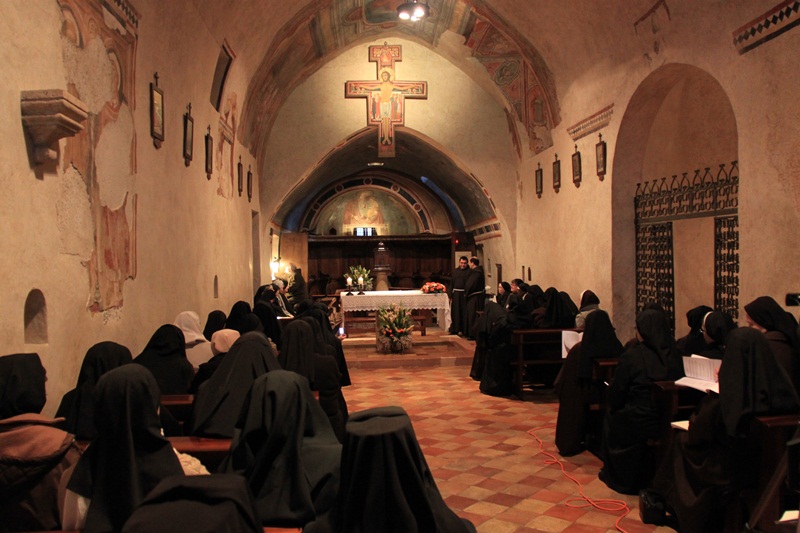
Church of San Damiano
Biographers of Saint Francis all agree that he had a transformative experience in an old and semi-abandoned church just below Assisi – the Church of San Damiano. There while he was enchantedly gazing at the painted wooden crucifix – a Byzantine image of the crucified Christ still alive on the cross – the silent voice of Jesus telepathically ‘spoke’ to Francesco, instructing him: “Francesco, Francesco, go and repair my house which, as you can see, is falling into ruins.” Thereafter, he devotedly began rebuilding San Damiano and other ruined churches, including the Porziuncola.
While repairing San Damiano, Francis often sang songs which spontaneously came to him. And he thereby attracted neighboring farmers and other visitors, presciently telling them that this ruined church would some day become a holy place attracting servants of God. And it did. As Francis predicted it was here that his friend Clara (Chiara), who became Santa Clara, founded Poor Ladies of San Damiano a female order and lived a cloistered life dedicated to Franciscan ideals of holiness and poverty.
Though Saint Francis took literally Jesus’ mystical message from the San Damiano crucifix, its true meaning proved metaphoric and profound. And by the end of his short lifespan, Saint Francis and his order had by their example inspired a renaissance of the Catholic Church from its then apparent corruption by worldly wealth.
Thus, as a pilgrim honoring Saint Francis, one of my most important planned destinations was the Church at San Damiano. At the Ananda Center I was urged to visit San Damiano for early morning mass then being celebrated by Franciscan Friars with beautiful ecclesiastic chanting. In following that advice, I was blessed with one of the most memorable and beautiful experiences of this lifetime.
Here is what happened.
My drive from the Ananda Center to San Damiano proved extraordinary. It was a sunny and beautiful spring morning, with azure blue sky and small white cumulous clouds. On turning off onto the quiet country road leading to my destination, the verdant landscape was ethereally beautiful – abounding with gorgeous blooming wild flowers. As I beheld this beauty it seemed as if I was enjoying a waking dream of being in heaven on earth. And again it invoked that sweet feeling of déjà vu which followed my first vista of the Assisi environs.
Thus, I arrived at the San Damiano chapel already in a somewhat ‘altered’ state of awareness, just as mass was about to begin. At the chapel portal I was surprised to see that the entire small sanctuary was already filled with people, and that I could not observe any remaining place to sit. So, as the chanting began, I stood at the chapel entry and began weeping with deep emotion of devotion. On observing me crying there, some compassionate worshippers squeezed together to make space for me to sit down.
Thereupon I sat down and continued crying with even greater emotional intensity. That is all I can remember of the mass.
Spontaneously, I went into a very deep state of meditation and lost all consciousness of what was happening. I don’t recall how long I was in that state. But when I awakened from it, there was not a soul in sight. I was seated all alone in the San Damiano chapel still in an ‘altered state of awareness’ and gazing at its painted wooden crucifix. * [see footnote].
Thereupon, a ‘silent voice’ from the crucifix telepathically said to me: “Ritorna a me!” – a message in Italian which I did not immediately understand.
For a while, my mind remained silent and my body remained still. When I finally reawakened to ‘normal’ body consciousness, I urgently needed to use a toilet. So I got up and left the chapel to find one.
But still there was not a soul in sight from whom I could get directions. So I wandered the empty corridors until soon seeing what appeared to be public rest rooms. But there were no signs with international gender symbols identifying them. Instead there were different Italian words on each door. But I couldn’t translate either of them. So, after momentary reflection, impelled by an urgent ‘call of Nature’ I entered what I guessed to be the men’s room. But I guessed wrong. Embarrassed, I made a quick exit, and used the other bathroom.
I left San Damiano wondering why God had addressed me in Italian, when I was so ignorant of that language that I couldn’t even find the men’s room.
Of course I soon learned – and will never forget – that “Ritorna a me!” meant “Return to me!” And I took it as a Divine message. Since then I have come to realize that, knowingly or unknowingly, every embodied human soul longs to return to its Divine Source. But that virtually all of us, including Ron, need frequent reminders of that eternal Truth.
Thus, I recall my extraordinary experience at San Damiano as such a reminder.
* This crucifix was an exact replica of the original crucifix worshipped by Saint Francis and Santa Clara, which for preservation had been previously removed to the Basilica of Santa Chiara in Assisi.
Excursion to Mount La Verna in Tuscany
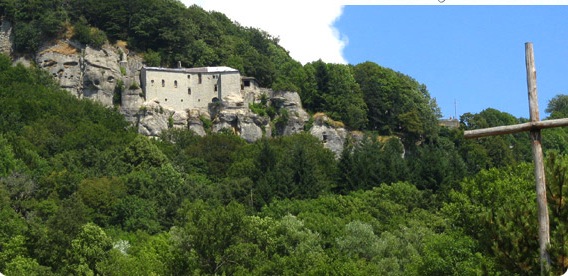
Mount La Verna Sanctuary
Notwithstanding my marvelous experiences of Saint Francis in and around Assisi, there remained on my pilgrimage itinerary an important place outside Assisi, Mount La Verna in Tuscany – where Francis became the first saint to receive the crucifixion stigmata of Christ. And also there remained for me great curiosity and a desire to solve the mystery of why – as a secular Jewish lawyer ignorant of Christian saints – I had developed a deep inner rapport with and love for Saint Francis, even before I had met my beloved Hindu Guruji, Shri Dhyanyogi Madhusudandas.
Before my midlife spiritual awakening, I had no inner visions and rarely remembered dreams. And even if I remembered them they were colorless and commonplace. But soon after my rebirth experience I had two repetitive extraordinary and mysterious visions or vivid dreams unlike any prior inner experience.
Twice, in semi-somnambulant states, I clearly perceived – like a slow motion ‘inner technicolor movie’ – a scene which I was viewing from a high aperture or window in a medieval building. * [see footnote]
I could not see any person at the aperture, but only experienced my consciousness being there and looking out. Below me were monks or friars clothed in simple robes or habits in a verdant open space midst trees surrounding the medieval structure from which ‘I’ was viewing them. Especially noteworthy was the extraordinary etherial light around that scene, which I immediately associated with Tuscany, the Italian state just North of Umbria, where I had visited in 1955.
So in 1992 I was anxious to visit Mount La Verna in Tuscany not only because Francis had his ultimate spiritual experience there, but also because of curiosity about those mysterious visions. However, because of my ignorance of the Italian language I was reluctant to journey alone from Umbria to La Verna. Then, synchronistically, a friendly multi-lingual Ananda center staff member familiar with La Verna and intermediate sites visited by Saint Francis compassionately offered to be my driver and tour guide for a full day’s excursion to those places.
The entire excursion proved a memorable experience in my already wonderful visit to Italy. With great interest, I saw various places known to Saint Francis. For example, we stopped at the town of Gubbio, where the saint is still venerated for legendarily confronting and taming a fierce wolf which was attacking townspeople and their livestock.
But for me our visit to the Mount Laverna sanctuary in the Tuscan Appenines proved the highpoint of our journey. Upon our arrival at La Verna, I immediately intuited – as we observed the grounds and structures there – that La Verna was the place in Tuscany which had appeared in my mysterious inner movie visions eighteen years earlier. Then, I meditated in a wooded area where, with renewed déjà vu, I again felt the supernally sweet presence of Saint Francis. As we departed from that lovely place, I felt great gratitude for our visit there, yet with continuing curiosity about the visions which had long preceded the visit.
Though I have ever since strongly felt that La Verna was the place which appeared in those early visions, their meaning remains an unsolved mystery. Perhaps in another lifetime I was at that place, when or after it was visited by Saint Francis. But I don’t know. And it’s probably not important that I know.
The Buddha taught that we should avert speculation which will not lead to edification. And speculation about imagined other life times can perhaps detract from fulfillment in this lifetime.
*I am describing these visions from memory, because I have not yet found any contemporaneous notes from over thirty years ago. After experiencing these visions I began regarding similar ‘inner movies’ as glimpses of other lifetimes.
Conclusion
My experiences of communion with Saint Francis of Assisi in places where he lovingly lived eight hundred years ago were memorably inspiring reminders of our human potential for humbly living a life of eternal love, even under difficult external circumstances. They strongly reinforced my continuing view of that great saint as an archetype to be emulated.
For an experience of the inspiring ambience bequeathed to us by Franceso’s life of love and humility, I highly recommend your viewing “Brother Sun, Sister Moon”, a 1972 film, masterfully directed by Franco Zeffirelli. Based on the life and legend of Saint Francis of Assisi, this two hour film is exceptionally beautiful and inspiring.

